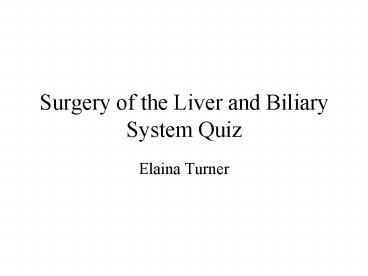Surgery of the Liver and Biliary System Quiz - PowerPoint PPT Presentation
1 / 25
Title:
Surgery of the Liver and Biliary System Quiz
Description:
Gall bladder. Common duct. Trace the flow of bile through the extrahepatic biliary system. Gallbladder cystic duct common bile duct duodenum ... – PowerPoint PPT presentation
Number of Views:339
Avg rating:3.0/5.0
Title: Surgery of the Liver and Biliary System Quiz
1
Surgery of the Liver and Biliary System Quiz
- Elaina Turner
2
List 3 types of neoplasm seen in the liver and
biliary system of the dog and cat and give their
prognosis.
- Hepatocellular adenoma ? good
- Hepatocellular adenocarcinoma ? single can be
good diffuse grave - Cholangiocellular carcinoma ? grave
3
Which of these is most common in the dog?
- Hepatocellular adenocarcinoma
4
Which is most common in the cat?
- Both adenoma and adenocarcinoma are common
5
Which one of these tumors would you be least
likely to feel during abdominal palpation?
- Cholangiocellular adenocarcinoma
6
Which tumor can be cured by surgical excision?
- Hepatic adenoma
7
Why is the liver more often damaged by blunt
trauma than most other abdominal organs?
- The liver can not slide out of the way because of
its many attachments to the body wall. This is
incontrast to the other abdominal organs which
can move freely about the cavity.
8
Which part of the liver is most commonly damaged?
Why?
- Free caudal aspect of the liver because
9
What is the most useful diagnostic modality in
detecting acute hemoperitoneum?
- Paracentesis or diagnostic peritoneal lavage
10
What is the most common tx for hemoperitoneum
secondary to hepatic trauma in dogs?
- Stabilization not surgery
11
When is exploratory celiotomy indicated? (Be
specific what CS would lead you to sx?)
- Evidence of continued hemorrhage
- This animal will be in shock tachycardia,
tachypnea, pale mm
12
You are exploring a dog following abdominal
trauma, and you find an area of tissue disruption
on the caudate lobe. Several blood and bile
vessels are ruptured and protruding from the
parenchyma. How will you handle this situation?
If the caudal margin of the caudate lobe is
crushed, what will you do?
- Superficial leave alone if no significant
leakage or hemorrhage present. Broad mattress
sutures to align tissue and resection of crushed
tissue. Use hemostatic clips on the blood and
bile vessels.
13
Briefly describe the finger-fracture method of
partial hepatic lobectomy.
- Used for deep injuries
- Incise capsule at margin of resection
- Crush parenchyma w/ fingers or scalpel handle to
separate the parenchyma from the vessels then - Ligate isolated blood and bile vessels
14
What is the advantage of the previous technique?
- Cutting through without doing the finger fracture
method causes severe hemorrhage.
15
Total lobectomy is easiest in which liver lobes
and in which patients?
- Small dogs and the left and non-central
divisions.
16
What is the major complication of hepatic
lobectomy?
- Hemorrhage
17
Why is it important to leave minimal amounts of
suture material and Gelfoam in the hepatic
parenchyma?
18
Is the previous a problem in cats as well as
dogs?
19
Why is microhepatica a contraindication for
percutaneous hepatic biopsy?
20
Describe the anatomical parts of the extrahepatic
biliary system.
- Cystic duct
- Gall bladder
- Common duct
21
Trace the flow of bile through the extrahepatic
biliary system.
- Gallbladder ? cystic duct ? common bile duct ?
duodenum
22
What steps must be taken to stabilize the patient
with biliary obstruction before surgery?
- Patient must be stabilized before sx
- Fluids, electrolytes and acid-base correction
- Antibiotics that concentrate in bile for
prophylaxis ampicillin, tetracycline - Vitamin K
- Fresh whole blood or fresh (frozen) plasma
23
In dogs, obstruction is secondary to
cholelithiasis, neoplasia or trauma. What is
another cause, seen in cats, in Flordia and St.
Kitts?
- Bile duct fluke
24
What are the indications for cholecystectomy,
cholecystotomy and cholecystoenterostomy?
- Cholecystectomy unresponsive cholelithiasis or
cholecystitis, severe trauma or neoplasia - Cholecystotomy cholelithiasis removal
- Cholecystoenterostomy neoplasia, calculi, etc.
25
Trace the flow of bile following cholecystectomy,
cholecystotomy and cholecystoenterostomy.
- Cholecystectomy
- Cholecystotomy
- Cholecystoenterostomy































